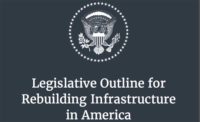Applications soon should start streaming in to the U.S. Dept. of Transportation for $1.5 billion of American Recovery and Reinvestment Act discretionary grants for a wide range of infrastructure projects. DOT on May 18 published detailed criteria it will use to select winners of what it dubs Transportation Investment Generating Economic Recovery (TIGER) grants.
“I would expect a high level of interest” in the new grants, says Jack Basso, American Association of State Highway and Transportation Officials’ director for program, finance and management. Cathy Connor, Parsons Brinckerhoff senior vice president for government affairs, adds, “I think the demand will be very large, very strong.”
Highway, transit and passenger-rail projects, which have separate, dedicated stimulus-act funds, can compete for the grants, along with port, freight-rail and multimodal projects, which do not have categorical ARRA funding. Jean Godwin, American Association of Port Authorities’ executive vice president, says, “I’m sure our members will be filing applications for grants.”
The maximum TIGER grant will be $300 million; the minimum will be $20 million. Total TIGER grants in any state are limited to $300 million. “Generally, these are supposed to be larger projects,” says David Bauer, American Road & Transportation Builders Association senior vice president for government affairs. But smaller jobs will be in the mix, too. ARRA gives DOT waiver authority to award grants of less than $20 million for projects in smaller localities. Applications are due by Sept. 15. DOT says it will pick winners “as soon as possible” after that, but no later than Feb. 17.
| Total: $1.5 billion, available through Sept. 30, 2011 |
| Grant size: $20 million to $300 million* |
| Per-state limit: $300 million |
| Application deadline: Sept. 17 |
| Grants awarded: No later than Feb. 17, 2010 |
| Eligibility: Projects with “significant impact on the nation, a metropolitan area or a region.” |
| Primary criteria: Long-term positive “outcomes” (infrastructure condition, economic competitiveness, livability, sustainability, safety); job creation-economic stimulus |
| Secondary criteria: Innovation (technology, finance, contracting, etc.); partnership (with localities, private sector, nonprofits, non-transportation agencies) |
| *DOT can issue waiver for grants less than $20 million. |
| Sources: Federal Register; American Recovery and Reinvestment Act |
DOT has two prime criteria: projects that promise “a significant impact on desirable long-term outcomes,” nationally or regionally, and can add or preserve jobs. Those “outcomes” include keeping infrastructure in “good repair,” contributing to economic competitiveness, making areas more “livable,” promoting environmental sustainability and enhancing safety.
Secondary criteria for TIGER grant projects are: innovation in areas such as technology, finance or contracting and partnership with localities, private companies or nonprofits.
DOT can stretch its TIGER dollars by using up to $200 million of the $1.5 billion for credit assistance under the 11-year-old Transportation Infrastructure Finance and Innovation Act (TIFIA) program, which provides projects with loans, loan guarantees or lines of credit. DOT says the $200 million could support about $2 billion in TIFIA aid.




Post a comment to this article
Report Abusive Comment